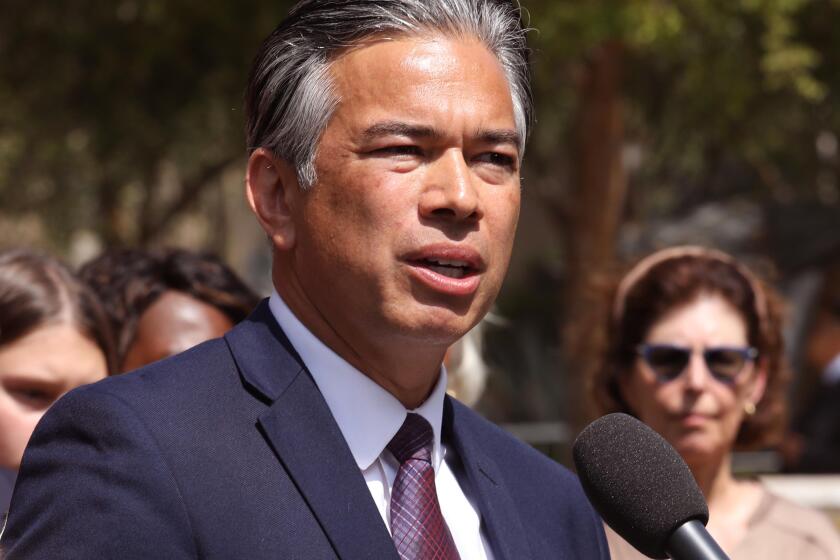Clinton Offers New Mexican Aid Plan, Bypasses Congress : Latin America: Proposal for $40 billion in loan guarantees is abandoned. Instead, U.S. will provide $20 billion of $49.8-billion package for faltering economy.
- Share via
WASHINGTON — Facing insuperable opposition in Congress, President Clinton abandoned his $40-billion program of loan guarantees for Mexico on Tuesday in favor of a bailout that will cut the U.S. contribution in half while gaining assistance from other nations and international lenders and that does not require congressional approval.
The new plan, endorsed by congressional leaders of both parties but greeted skeptically by some backbenchers, will give Mexico a $20-billion package of U.S. loans and loan guarantees--the federal government’s assurance to private lenders that they will be repaid by the U.S. Treasury if Mexico defaults.
In addition, the International Monetary Fund will provide $17.8 billion; the Bank for International Settlements, a European-based lending institution, $10 billion, and Canada and several Latin American nations a total of $2 billion, bringing the value of the package to $49.8 billion.
The program was assembled hastily over two days, as the Mexican economic crisis worsened and congressional leaders told Clinton that they needed at least two weeks to persuade the House and Senate, where opposition appeared to be growing more fierce each day, to approve the original $40-billion loan guarantee program.
At a meeting in the Oval Office at 11 p.m. Monday, Clinton decided, instead, to take advantage of a provision in U.S. law that allows him, without congressional approval, to draw from the Exchange Stabilization Fund. The fund is a government account established in 1934 during the Great Depression to provide stability in currency exchange markets. The fund, which includes dollars and foreign currency, was recently valued at $37.5 billion.
Clinton said that he decided to act without awaiting congressional approval of the original plan because “the risks of inaction are greater than the risks of decisive action.”
“Do I know for sure that this action will solve all the problems? I do not. Do I believe it will? I do. Am I virtually certain that if we do nothing it will get much, much worse in a hurry? I am,” the President said in a speech to the National Governors Assn., at which he announced the new plan Tuesday morning.
Without action, financial experts feared that Mexico would find itself in default within a week, a situation that could lead several other Latin American nations into default and precipitate a global economic crisis. Some members of Congress said that Administration officials feared such a collapse was no more than two days away.
The solution the President offered would allow Mexico to exchange short-term debts for loans with maturities of as much as 10 years to overcome immediate problems stemming from the drop in the value of the peso at a time when billions of dollars in short-term debts are coming due.
Immediately after Clinton’s plan was announced, the Mexican stock markets surged, gaining 10% by the end of the day--the largest single-day gain in seven years--while the beleaguered peso recovered major losses against the U.S. dollar. The devaluation of the peso Dec. 20 initiated the crisis.
A dollar fetched 5.8 pesos by the close of trading Tuesday, a considerable one-day gain since Monday, when it took 6.35 pesos to buy a dollar, but still down approximately 45% since before the devaluation.
“The financial package means that the liquidity problem will be overcome,” said Mexican President Ernesto Zedillo, a 42-year-old Yale-educated economist.
Zedillo vowed to continue economic reforms, including large-scale privatization of the nation’s railroads, airports and ports. But he said the huge credit line represented international “recognition of the solid economic basis of our country.”
The Clinton Administration’s concern was that a failing economy in Mexico, the United States’ second-largest customer, could throw out of work thousands and thousands of Americans whose jobs depend on exports to Mexico; cause a run toward the U.S. border by Mexicans seeking to enter the United States illegally in search of jobs, and weaken confidence in other emerging markets.
Under terms of the program, Mexico will be expected to pay fees likely to range from 5% to 10% of the private loans that are guaranteed. It will pay interest rates on the U.S. government loans that will be set above comparable Treasury rates, to encourage it to return to the private capital market as quickly as possible. In addition, Mexico will be required to file quarterly reports on its economic restructuring to permit close international monitoring.
As collateral, Mexico will put up a certain amount of the $6 billion to $7 billion it earns each year selling oil beyond its borders, Administration officials said.
While Administration officials insisted that they acted under strict provisions of the law, some financial analysts raised the possibility that Clinton could be misusing the Exchange Stabilization Fund by going beyond its short-term mandate and making longer-range loans available. Others criticized Clinton for avoiding Congress.
“I don’t care whether it comes out of ESF or EPA. It’s still taxpayer money . . . and, when you’re going to expose the taxpayers to a $20-billion risk, you ought to have a vote on it in Congress,” said Sen. Robert C. Smith (R-N.H.).
Asked why they had not chosen the new course three weeks ago, when they first sought congressional approval of the loan guarantee program only to run into a growing wall of opposition, Administration officials said that Clinton preferred an approach that would give Congress a voice in policy. But the growing urgency of the situation finally demanded unimpeded action, they said.
Jeffrey Schott, a former Treasury official now working at the Institute of International Economics, a Washington policy research organization, said, however, that the delay in acting was more telling than the action itself.
“It has been amply demonstrated that even with the support of the President and the leadership of Congress, the United States cannot act. What does that mean for future attempts to deal with economic problems, whether domestic or international? It damages the nation’s reputation and puts up a sign (that) we’re still in gridlock city,” he said.
In the face of rising opposition to the original plan, Clinton met in the Oval Office on Sunday morning with key officials to begin forming a fallback plan.
They agreed it was imperative that congressional officials prepare legislation authorizing the original $40-billion plan by Monday or the entire effort would collapse--a timetable Clinton passed along that afternoon to House Speaker Newt Gingrich (R-Ga.), Senate Majority Leader Bob Dole (R-Kan.), House Minority Leader Richard A. Gephardt (D-Mo.) and Senate Minority Leader Tom Daschle (D-S.D.).
The congressional leaders were pessimistic about putting together a bill that would satisfy deeply skeptical legislators on both sides of the aisle.
By midday on Monday, Gingrich told Panetta that he was having trouble keeping Republicans on board. Gephardt, whose problems with Democrats were even greater, had not been heard from.
Finally, shortly after 8 p.m. Monday, Gingrich called the White House and broke the news: The legislative package was dead.
Treasury officials immediately began work on a plan using the currency stabilization fund to prop up the peso, and they called central bank and International Monetary Fund officials to line up support from other lenders.
Clinton convened the bipartisan leadership in the Cabinet Room at 8:45 a.m. to announce terms of the deal.
Times staff writers Mark Fineman in Mexico City, Doyle McManus in Boston and Michael Ross in Washington contributed to this story.
* BACK FROM BRINK: Last-minute loans help Mexico avert economic disaster. D1
Why the Peso Matters
* Times on Demand has compiled four articles explaining why Mexico’s economic problems affect the United States. To order, call 808-8463, press *8630 and select option 1. Order Item No. 2829. $4, plus 50 cents delivery.
More to Read
Sign up for Essential California
The most important California stories and recommendations in your inbox every morning.
You may occasionally receive promotional content from the Los Angeles Times.









